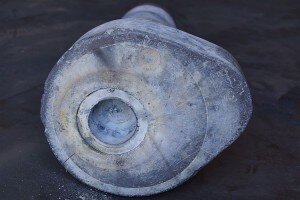Pre-Storage Pump Inspection - Maintenance Pumps
Factory Evaluation
Any or all components can be sent to High Temperature Systems, Inc. for inspection and evaluation. The most accurate evaluation requires complete chemical removal of the metal from the graphite surfaces. This is especially true for proper inspection of the pump base. Contact High Temperature Systems, Inc. prior to shipment of any components. (The cost of evaluation can be credited to the overall price of a pump rebuild.)
Wear Inspection
All components need to be inspected for unusual or excessive wear. This will require allowing the pump to fully cool and removing the shaft and impeller. Follow the pump manuals guidance for removing the shaft and impeller.
Impeller and Shaft Inspection
The impeller and shaft typically wear the most during normal operation. Compare the used impeller and shaft to new/spare units to assess the wear. Wear of more than 1/4" or 6mm indicates that replacement is needed. Small gaps between the impeller and volute reduce the maximum pump head and overall pump efficiency. If the pump volume was acceptable prior removing from the molten metal bath, you may choose to continue to use the existing impeller.Carefully inspect the impeller bearings to ensure they are firmly attached to the graphite components. Depending on the impeller design, there will be one or two bearings at the top or bottom of the impeller. Gaps or voids between the bearing material and graphite indicate excessive wear and the unit should be replaced.The shaft typically accumulates some excessive dross deposits near the metal line during operation. This material should be removed to prevent a poorly balanced shaft and excessive vibration. If the material does not peel away from the shaft, it is best to discard the shaft. Remember that excess pump vibration can significantly accelerate wear and permanently damage most pump components.Inspect the shaft for excessing "waisting". This is a condition in which the diameter of the shaft decreases due to oxidation above the metal line. More than 1/8" or 3mm of oxidation erosion is considered excessive and the shaft should be discarded.A pump equipped with a Rock Catcher will typically have a shaft bearing. The bearing is positioned at the top of the Rock Catcher. If the pump is equipped with a Rock Catcher, inspect the shaft bearing for wear as well as voids or gaps between the bearing material and the graphite shaft.Carefully inspect the shaft and impeller for cracking. Cracks that may result in small chips are less critical. However, cracks that appear to radiate radially, will likely lead to a major failure. Cracked graphite cannot be repaired and should be discarded.
Base Inspection
The base is typically the most robust component of the graphite molten metal pump components. It undergoes little oxidation during uses since it is typically fully submerged below the metal line. Exceptions would be if the pump was operated under excessive vibration conditions or if an impeller lost a bearing. Inspect the pump carefully looking for gaps or voids between the bearings and the graphite material. Most pump bases have two bearing, but some are constructed with only one bearing.Carefully inspect the base for cracking. Cracks that may result in small chips are less critical. However, cracks that appear to penetrate deeply, will likely lead to a major failure. In typical operation, a pump base can be rebuilt 2 to 3 times over its life; therefore it is recommended that the base be returned to High Temperature Systems, Inc. for evaluation and possible rebuild.
Riser Inspection
Note: Not All Pumps Have Removable Risers.Some pumps are equipped with removable risers. If you are not certain if your pump is equipped with a removable riser, do not attempt to remove the riser.Using a flashlight, inspect the inside of the riser for obstructions. 80% of the cross section of the riser should be free of frozen metal or obstructions. It is not recommended to attempt removal of material inside the risers. If a riser is clogged, it should be replaced. If the riser is not removable, the cartridge should be returned to High Temperature Systems, Inc. for rebuild.Inspect the outside of the riser for cracking or waisting. As with the shaft, waisting is usually caused by oxidation above the metal line. More than 1/8" or 3mm of waisting indicates a worn riser that should be discarded.
Repair Recommendation
The manual provided with the pump includes recommendation of the replacement of most components from shaft/impeller to replaceable risers. Some features are available on some models of pumps that make field repairs easier. These include:
Threaded Posts - Threaded support posts and threaded base sockets. This allows a post to be replaced in the field provided the base is sufficiently clean of metal.
Replaceable Risers - Risers that are socketed instead of cemented in place.
Riser Clean-Outs - Risers equipped with a top-side clean-out.
All pumps feature these field replaceable units:
Threaded Impellers - Threaded shafts and impellers make impeller replacement quick and easy.
Safety Couplings - All pumps are equipped with a break-away motor shaft to impeller shaft coupling. There are two available designs. The most common used a sacrificial shear pin that is easily replaced. This coupling is strongly recommended for rough duty environments. The alternate coupling is designed for very fast shaft replacements, but the shaft is the sacrificial component.
Any repairs not detailed in your pump manual, should be performed by High Temperature Systems, Inc. As an example, a pump cartridge includes the base, posts, and riser. This assembly is pre-aligned for the motor mounts. If the pump is not equipped with a replaceable riser, it is strongly recommended that the cartridge be returned for repair; rather than attempting a field repair.

